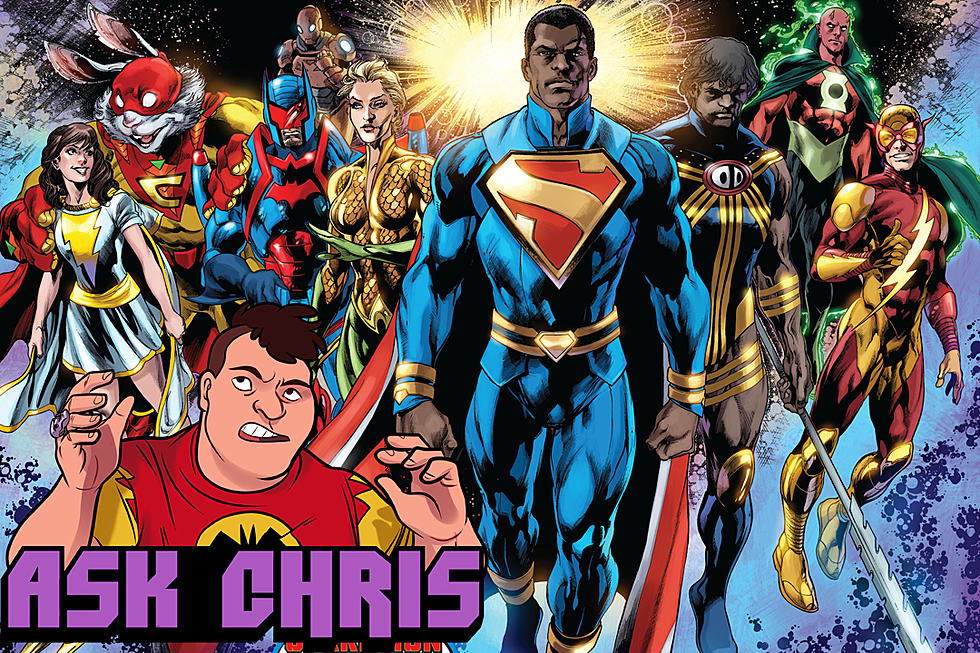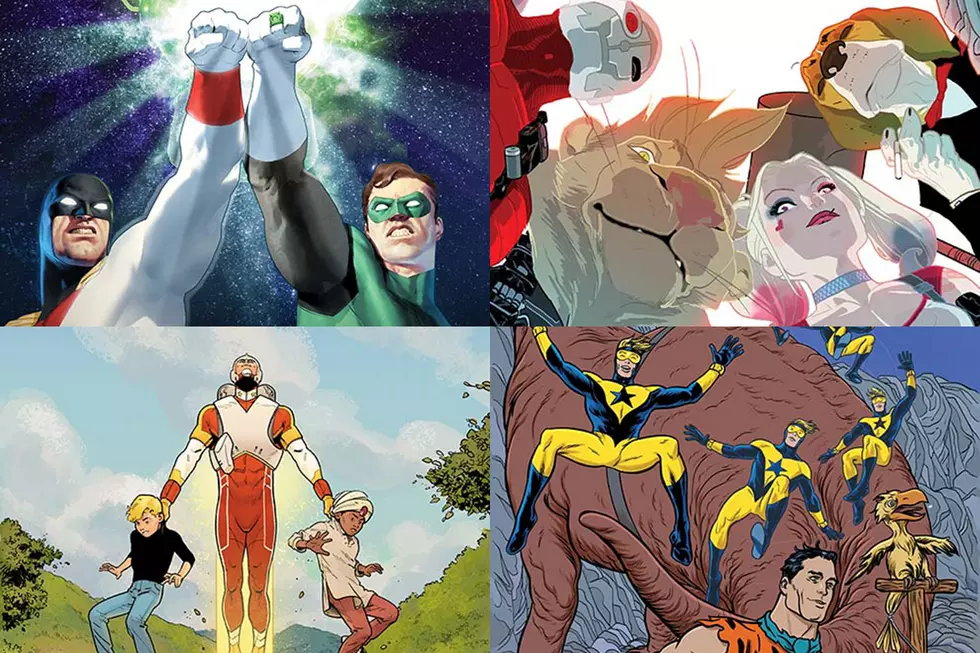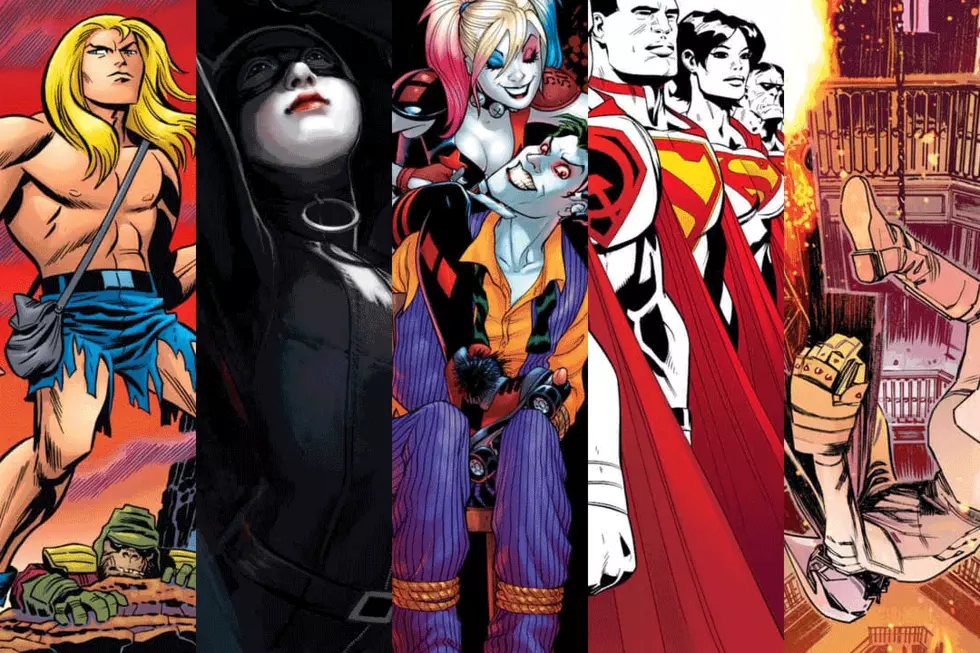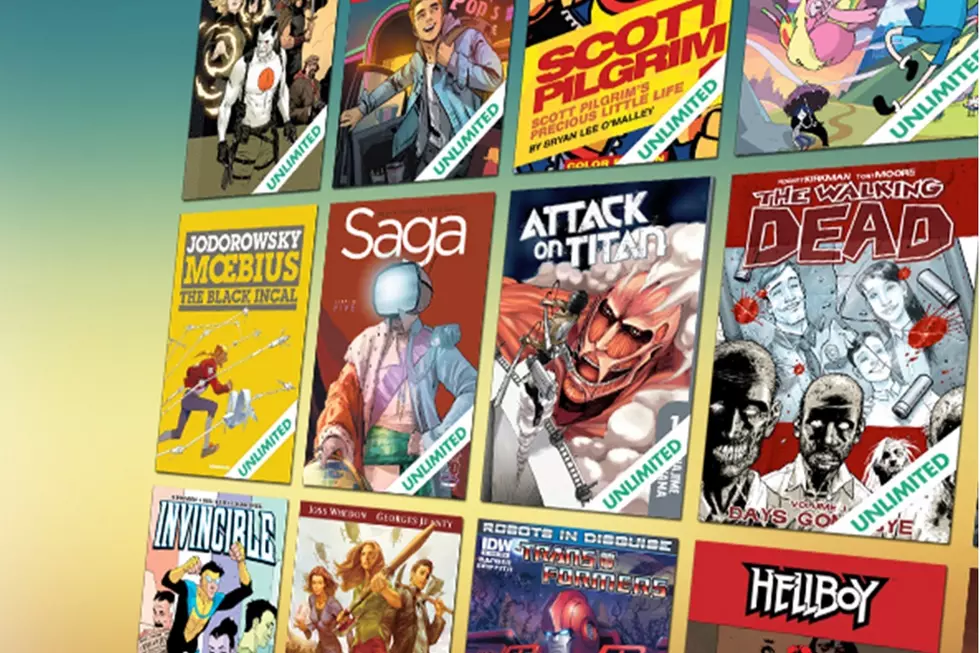![Conversing About ‘Convergence’ with DC’s Dan DiDio [Interview]](http://townsquare.media/site/622/files/2015/02/ConvergenceHeader.jpg?w=980&q=75)
Conversing About ‘Convergence’ with DC’s Dan DiDio [Interview]
Convergence is drawing ever closer; a massive not-quite-in-continuity crossover event that replaces all of DC's monthly titles for two months this spring, to throw together interpretations of characters from throughout DC history on an isolated world where they will end up fighting a lot. The event is comprised of a weekly miniseries by writer Jeff King and artists Carlo Pagulayan and Jason Paz that delivers the central overarching plot line, and a number of character-focused two-issue miniseries that will expand on the themes of the weekly series, provide additional context, and revive fan-favorite versions of many classic DC heroes and villains.
It's a huge, massively ambitious undertaking, so we spoke to DC co-publisher Dan DiDio to get a better idea about the publisher's plans, the company's overall goals for the event, and the impact it will have on the DC universe in the future.
ComicsAlliance: We know that Convergence centers on a threat to the entire multiverse, so how closely does this event tie in to Grant Morrison's Multiversity? Does that series help set the stage and prep readers for what's coming in Convergence?
Dan DiDio: I actually just finished a forty-five minute conversation with Grant about this very topic! [laughs]
Actually, yeah I think you're going to see some real connective tissue between Multiversity and Convergence. I mean, the amount of time and energy that Grant and the editorial team have spent on fleshing out, explaining, and expanding on what the DC multiverse is – it's an incredibly comprehensive story, and it really is a blueprint, not just for the Multiversity series, but for the entire future of the DC universe as well. So, when we knew this book was being created and we were creating Convergence, there were a lot of natural connecting points between the two. And if you're a fan of Multiversity, and a fan of the multiverse, I think you'll be very excited to see how this all comes together.
CA: So we should keep those Multiversity poster maps close at hand?
DD: As a matter of fact, the funny thing is that the Convergence world is actually on that Multiverse map! It's a little circle at the bottom of the map, with a question mark – we didn't want to tip our hand when the map was created, but the Convergence world is on there.
CA: Well then, in addition to Multiversity, are there other DC books readers catch up on or revisit in the lead-up to this?
DD: Well, there are a couple things… One is that Multiversity is key to what happens, and the events that are taking place in both Future's End and World's End are also integral to the actual story itself – and the Superman 'Doomed' storyline that took place last year is actually part of the Convergence zero book and an important part of the set-up for the series. So I think those are the direct ties.
And what we're also doing is, in each one of the monthly books in April, we have a two-page primer so that everyone can be familiar with the important bits and pieces of each character's history and be able to get really up to speed so we can see where in their lives we're joining the characters and understand how that plays to the overall story.
CA: So with something like this that's such a big event and a cornerstone of DC's publishing plan, how do you reconcile the demands of making it appeal to long-time fans, while also reaching the new readers who hear the buzz and decide to give it a try?
DD: Well honestly, what we've found in the past is – and this is through a lot of anecdotal information that we've heard at conventions and such – a lot of readers out there, their first introduction to the DC universe or the Marvel universe or any universe is through the major events, or through a major story in some way.
It's funny, you'd think that would be off-putting, but a lot of people get attracted by all the attention a story's getting, and want to sample it and learn more about the characters, and that pulls them into the world. I hear from a lot of fans that their first comic was Crisis On Infinite Earths or their first comic was Final Crisis or Identity Crisis. These events actually pull them in. Our goal with this story is to pay tribute to so many great generations of our characters, so there's a little bit for everybody who was a DC fan or is a current DC fan, but we're also hoping the scale and scope of the story will bring in new readers and get them excited.
And honestly, that's one of the reasons that we're using Jeff King as our writer – he's an incredibly talented writer that's new to comics, and he's approaching this story with a really keen eye, and he's trying to do things in a way that he would understand, so readers don't feel overwhelmed by the information, but are caught up in the overall story, and get pulled into the series.
CA: I was actually just about to ask about Jeff – he has an impressive CV in TV, but as you said, he's new to comics. So how did you find him, and what convinced you that he was the man for this job? It's pretty high-profile for a debut project.
DD: It's rather serendipitous, actually. What had happened was the lattice for Convergence was created by the writers that are working on Future's End, with contributions from both Scott Snyder and Scott Lobdell on top of that, so we had a lot of people really filling in the infrastructure for the story.
But a lot of these guys, their schedules are so full, they couldn't also take on a major story event like this. So we were trying to figure out ways to handle the series, and – true story – Jeff was working on White Collar, he's a big comic fan, and he came by for a tour! He stopped in my office, we began talking, and through the conversation, he saw all the boards with the basic information for what would become Convergence, and he said, "Well, you could be doing this, and you could be doing that," and was adding to the story right there.
And his quick take and his level of understanding excited me, because he was saying things that were dead-on and obvious, but that we had not seen because we were so close to the material. So I asked him if he wanted to get involved, and his schedule had opened up to the point where he could actually take on the book itself. And it's been a really fun ride! I keep on apologizing to him for throwing him in the deep end of the pool, and he said "don't worry about it, I don't care how deep the water is, I can swim through anything".
CA: That's almost the cliché of every comic fan's dream: come for a tour of the DC offices, leave writing a book!
DD: Yeah, it's the craziest thing in the world, but in this case, I think it's worked out extraordinarily well for us.
CA: In addition to the central Convergence series, there's the whole host of two-issue minis being launched as tie-ins – how did you determine what those titles would be? Did you solicit pitches, did you assemble the creative teams first and let them pick things, did you have specific titles you wanted to advance the overall arc of the story (and the universe)...?
DD: The answer is yes to all of those, in some weird way. The way it worked out is, we knew we had very clear, identifiable periods of time in DC history: Crisis On Infinite Earths, Zero Hour, Flashpoint, and so on. And because of these events that basically stopped and restarted the universe, a lot of things changed. So for each one, we looked at the books that clearly identified that period of time. What were the stories that were unique to that period? What were the things that people remember most?
And we looked at the first week of the event, which is set in the pre-Flashpoint universe – what stories were left unresolved that we think the fans would get excited to see? And we developed those, and then found the talent that could best execute those books.
Then we looked at the second week, and said "this is the generational interpretation, the pre-Zero Hour DCU where a lot of characters were being replaced", so we wanted to capture that generational moment where you had the Azrael Batman, where you had Hal Jordan as Parallax and Kyle Rayner taking over as Green Lantern, you had different interpretations of characters that people were very familiar with.
Then we went to the third week, and said "here we are, this is pre-Crisis, your classic interpretation of characters, so what are the ones we'd like to see in their purest form?" And those are the books we put in the third week – although, I have to say, because of the way the story works, we have Justice League Detroit out there, and I don't think everyone necessarily agrees that Justice League Detroit is the classic interpretation. But heck, it works for the story!
And then week four, we looked at – also pre-Crisis, but the books that captured the golden age of DC Comics, so we have Earth-2 characters in there, we have other worlds that were eliminated or combined in Crisis, and we pulled them out to be unique in their own right again, because we wanted to pay tribute, but also because we thought it would be fun. And I think when you look at the four weeks combined, you get a really brilliant snapshot of the DC universe, and the history of DC Comics.
CA: What role have you played in developing all this? Would you refer to yourself as an architect, a sounding board, an idea man, a general oversight committee…?
DD: It's so hard to say, because as I said, we started with the core team and quite honestly, from where we started with them and how we grew and evolved the central story, it became something completely different. What might have been a focus on just one period of time at the start of the conversation, turned into this wider range of characters and books. And that's where the talent really came in – we talked to the talent, we saw what characters got the creators excited, and saw what they wanted to revisit, and then that helped determine what books would make the final schedule and which ones didn't. It was an evolving process that kept on moving forward until we settled on the forty books.
CA: Were there things you personally were hoping for from this, and characters or creators you were pushing to have represented?
DD: Yeah, there's a few things that I wanted! One of the things you're going to see is that each week we tried to give it some level of structure, because when we first started, it was very randomized with different cities and different characters fighting – it didn't feel like it had a focus. And we really wanted to focus on one city, but then have other cities intruding on their world each week.
So the first week, you're looking at the pre-Flashpoint DCU, a city from that world, and there are three battle cities for that particular week. And you'll see the Flashpoint characters interacting with them, you'll see the Extremists characters, and you'll also see characters from Captain Carrot's universe interacting with them. And so, each week has a very particular focus of who's interacting, and I think that helps bring some structure to the overall story.
You'll see a greater level of crossover, with all the cities interacting with each other, in the spine Convergence book, but we wanted to have some structure on the monthly books because we wanted the books to focus on the characters who are the top liners. We wanted the books to be about them, so it wasn't just about the battle and who's going to win, but was also about revisiting or reintroducing characters that people really cared for and had relationships with over the years.
CA: So with that central series providing the foundation, the spine, as you say, and the minis pushing outward, providing scope and scale – will the main Convergence book also pull in characters and elements that won't be appearing in the minis?
DD: Yes. Like I said, we keep the focus on a certain number of cities in the monthly books, but there are other cities featured that are unique to the spine series. And one other thing that I haven't said anywhere else: there is a unifying moment the first month that plays out in the spine book, and also a unifying moment in the second month in the spine book, so you know clearly how all these stories fall, and how all these stories should be read – because we wanted all the two-part stories to play on their own, and have some level of resolution and conclusion to them, but we wanted to show how they fit into the overarching story as well.
CA: In addition to bringing back some fan-favorite characters, there are a number of well-loved, marquee-name creators returning to the DC fold for these two-part stories – as well as some teams who are newer to the DCU fold. Can we anticipate any of these creators working on other DC projects post-Convergence?
DD: Well, we've gathered so many people to work on Convergence, and we have plans for some of them after – we're always looking to add people to our roster. Our goal for everything is to tell the best stories with the best talent. And that's the great part. Right now we've expanded ourselves outwards, we're working with new talent, but that's not to the detriment of talent we've worked with in the past. We're trying to be as inclusive as possible, while pushing the DC universe forward.
CA: So back to the actual story, most of what we know right now is that there are these colliding cities, and that Brainiac serves as the initial catalyst and the main villain – or at least, the main villain that we know of...
DD: Yeah, the main villain that you know of, that's true! [laughs]
CA: And given that Brainiac is one of Superman's arch-enemies, and you said that the Superman 'Doomed' story helps lead into this event, can we assume that Superman – or SuperMEN, given all the parallel worlds involved – will play a central role in the story?
DD: There's plenty of Superman inside the story, that kinda goes without saying – especially when we're visiting the worlds of Kingdom Come and Red Son and other fine places that DC has created over the years – and there are also intrusions into the current world, so the present interpretation will also feature in the spine series.
CA: I imagine you can't say too much about this yet, but there have been a few eras of DC when continuity was recognized and respected, but wasn't the be-all end-all – I'm thinking of the brief reign of "Hypertime", Flashpoint, Multiversity, or even the launch of the New 52, where titles reveled in the glee of creation without being overly beholden to what went before. So, especially when you're dealing with a big event and its aftermath, how carefully do you weigh the importance of continuity, and then balance it with freeing yourselves to tell the best possible stories?
DD: Well, I think I've said this in another interview – continuity can be added value, it can be expansive, and it's what our universe is based on, but it also can be a crutch, and it can weaken storytelling. And right now, what we're focused on is bringing the strength of our characters into the spotlight, so we don't want to inhibit the storytelling with too much baggage – we want to do things that we feel have long-term potential, and grow where our characters can be and what they can do.
CA: Another interesting aspect of the event is the variants you recently revealed – each book will also be available with a cover designed by Chip Kidd...
DD: Yes!
CA: …I don't normally care for variant covers, but those are REALLY beautiful. How did those end up happening?
DD: Y'know, there's no secret in this building of what a fan I am of Chip Kidd's work. I think he's one of the best designers in the business, we've worked with him for a long time, and he always finds a way to innovate and do something different.
And when we reached out to him, we basically said, "Listen, we want to do something that unifies the weeks, that'll be a tribute to the original art and the interpretations of our characters, something that was kinda Lichtensteiny in its own way. And Chip came back with this look, and for me, it's really dramatic. We could've just done straight lifts of interior art, but he found a way to use a unifying color for each of the weeks, and to really make them stand out as a unit, which is what we were looking for. We could put a lot of covers on the shelves, we could have put a lot of things out there, but I was really looking for something that had that look and style, and I think he knocked it out of the park.
CA: The visual element of the characters fading into the color, it's a really neat narrative trick.
DD: And I can't express properly how much time, energy, and effort he put into it, and how much love he put into the work. He was in the DC library, and he was going through so much material, so many interiors. And there's a companion cover the second month, and when you see how it all works… It's rather unique, it's rather stark, and I think once you see it out there, it's attractive and it does everything a cover should do. And since doing these covers, we're gonna sacrifice the normal construction of logo placement and things like that, it allows the art to speak directly to the buyer.
CA: Taking this event, and then looking at the announced slate of titles you'll be publishing after Convergence wraps up, it seems you want to shake things up, without losing the things that are working. Is that a difficult line to walk, from a creative and marketing perspective?
DD: I think that's the challenge we have everyday. Whether event or nothing, we're always asking our talent to take risks and try things differently, we're always trying to push the envelope and see the characters in a different light, and the fear is always there that you're going to turn off as many people as you might turn on. So you have to have belief in what you're doing, you have to have conviction in your story, and a plan when you're rolling it out. And you can usually tell which books have plans and which ones don't.
And as I've said, I think the comic book audience is extraordinarily loyal and extraordinarily fickle at the same time. So if you prove to them you have belief and a long-term strategy in place, they will follow with you. And if you show that things are just being put together slapdash, then they will leave you. And our goal is to put our energy and focus into this event, and in the months to come we want to reengage our fans, show them that we're well aware of their interest and love in DC history, and also show them that we're looking to the future. We're still taking risks, and still being the company that we are.
Times change and we've gotta change with them, but at the core, our characters will remain, and hopefully the audience's love for the characters will always be there.
More From ComicsAlliance

![An Epic Adventure Is Underway In ‘The Kamandi Challenge’ #1 [Preview]](http://townsquare.media/site/622/files/2016/12/KACHA_Featured.jpg?w=980&q=75)



![Everything We Can’t Wait To See At San Diego Comic Con, Part Two: Saturday & Sunday [SDCC 2016]](http://townsquare.media/site/622/files/2016/07/SDCC-Sat1.jpg?w=980&q=75)



